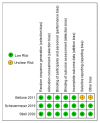Electric Cardioversion vs. Pharmacological with or without Electric Cardioversion for Stable New-Onset Atrial Fibrillation: A Systematic Review and Meta-Analysis
- PMID: 36769812
- PMCID: PMC9918032
- DOI: 10.3390/jcm12031165
Electric Cardioversion vs. Pharmacological with or without Electric Cardioversion for Stable New-Onset Atrial Fibrillation: A Systematic Review and Meta-Analysis
Abstract
Background: There is no clear consensus on the preference for pharmacological cardioversion (PC) in comparison to electric cardioversion (EC) for hemodynamically stable new-onset atrial fibrillation (NOAF) patients presenting to the emergency department (ED).
Methods: A systematic review and meta-analysis was conducted to assess PC (whether being followed by EC or not) vs. EC in achieving cardioversion for hemodynamically stable NOAF patients. PubMed, PubMed Central, Embase, Scopus, and Cochrane databases were searched to include relevant studies until 7 March 2022. The primary outcome was the successful restoration of sinus rhythm, and secondary outcomes included emergency department (ED) revisits with atrial fibrillation (AF), hospital readmission rate, length of hospital stay, and cardioversion-associated adverse events.
Results: A total of three randomized controlled trials (RCTs) and one observational study were included. There was no difference in the rates of successful restoration to sinus rhythm (88.66% vs. 85.25%; OR 1.14, 95% CI 0.35-3.71; n = 868). There was no statistical difference across the two groups for ED revisits with AF, readmission rates, length of hospital stay, and cardioversion-associated adverse effects, with the exception of hypotension, whose incidence was lower in the EC group (OR 0.11, 95% CI 0.04-0.27: n = 727).
Conclusion: This meta-analysis suggests that there is no difference in successful restoration of sinus rhythm with either modality among patients with hemodynamically stable NOAF.
Keywords: cardioversion; electrical cardioversion; new-onset atrial fibrillation; pharmacological cardioversion.
Conflict of interest statement
The authors declare no conflict of interest.
Figures






Similar articles
-
Early or Delayed Cardioversion in Recent-Onset Atrial Fibrillation.N Engl J Med. 2019 Apr 18;380(16):1499-1508. doi: 10.1056/NEJMoa1900353. Epub 2019 Mar 18. N Engl J Med. 2019. PMID: 30883054 Clinical Trial.
-
Cardioversion of acute atrial fibrillation in the emergency department: a prospective randomised trial.Emerg Med J. 2012 Mar;29(3):188-91. doi: 10.1136/emj.2010.109702. Epub 2011 Mar 21. Emerg Med J. 2012. PMID: 21422032 Clinical Trial.
-
Electrical versus pharmacological cardioversion for emergency department patients with acute atrial fibrillation (RAFF2): a partial factorial randomised trial.Lancet. 2020 Feb 1;395(10221):339-349. doi: 10.1016/S0140-6736(19)32994-0. Lancet. 2020. PMID: 32007169 Clinical Trial.
-
Effect of Early Pharmacologic Cardioversion vs. Non-early Cardioversion in the Patients With Recent-Onset Atrial Fibrillation Within 4-Week Follow-Up Period: A Systematic Review and Network Meta-Analysis.Front Cardiovasc Med. 2022 Apr 11;9:843939. doi: 10.3389/fcvm.2022.843939. eCollection 2022. Front Cardiovasc Med. 2022. PMID: 35479281 Free PMC article.
-
The impact of a nurse-led elective direct current cardioversion in atrial fibrillation on patient outcomes: A systematic review.J Clin Nurs. 2019 Oct;28(19-20):3374-3385. doi: 10.1111/jocn.14852. Epub 2019 May 5. J Clin Nurs. 2019. PMID: 30916816
Cited by
-
What Mistakes Can Be Made When Performing the Electrical Cardioversion Procedure?-Analysis of Emergency Medical Team Performance during the Championships in Emergency Medicine.Healthcare (Basel). 2024 Aug 29;12(17):1724. doi: 10.3390/healthcare12171724. Healthcare (Basel). 2024. PMID: 39273748 Free PMC article.
-
Effect of non-invasive rhythm control on outcomes in patients with first diagnosed atrial fibrillation presenting to an emergency department.BMC Emerg Med. 2025 Mar 3;25(1):35. doi: 10.1186/s12873-025-01194-z. BMC Emerg Med. 2025. PMID: 40033211 Free PMC article.
-
Effectiveness of Immediate Pharmacological Versus Electrical Cardioversion on Hemodynamic Stability and Rhythm Restoration in Patients With Refractory Atrial Fibrillation: A Systematic Review.Cureus. 2025 Jun 25;17(6):e86747. doi: 10.7759/cureus.86747. eCollection 2025 Jun. Cureus. 2025. PMID: 40718243 Free PMC article. Review.
-
Effectiveness of Transesophageal Echocardiography in Preventing Thromboembolic Complications Before Cardioversion: A Narrative Review.Cureus. 2023 Nov 2;15(11):e48149. doi: 10.7759/cureus.48149. eCollection 2023 Nov. Cureus. 2023. PMID: 38046740 Free PMC article. Review.
References
-
- Hindricks G., Potpara T., Dagres N., Bax J.J., Boriani G., Dan G.A., Fauchier L., Kalman J.M., Lane D.A., Lettino M., et al. 2020 ESC Guidelines for the Diagnosis and Management of Atrial Fibrillation Developed in Collaboration with the European Association for Cardio-Thoracic Surgery (EACTS) Eur. Heart J. 2021;42:373–498. - PubMed
-
- Stiell I.G., Sivilotti M.L.A., Taljaard M., Birnie D., Vadeboncoeur A., Hohl C.M., Mcrae A.D., Rowe B.H., Brison R.J., Thiruganasambandamoorthy V., et al. Electrical versus Pharmacological Cardioversion for Emergency Department Patients with Acute Atrial Fibrillation (RAFF2): A Partial Factorial Randomised Trial. Lancet. 2020;395:339–349. doi: 10.1016/S0140-6736(19)32994-0. - DOI - PubMed
-
- Dankner R., Shahar A., Novikov I., Agmon U., Ziv A., Hod H. Treatment of Stable Atrial Fibrillation in the Emergency Department: A Population-Based Comparison of Electrical Direct-Current versus Pharmacological Cardioversion or Conservative Management. Cardiology. 2009;112:270–278. doi: 10.1159/000151703. - DOI - PubMed
-
- PROSPERO. [(accessed on 26 December 2022)]. Available online: https://www.crd.york.ac.uk/prospero/#recordDetails.
Publication types
LinkOut - more resources
Full Text Sources

